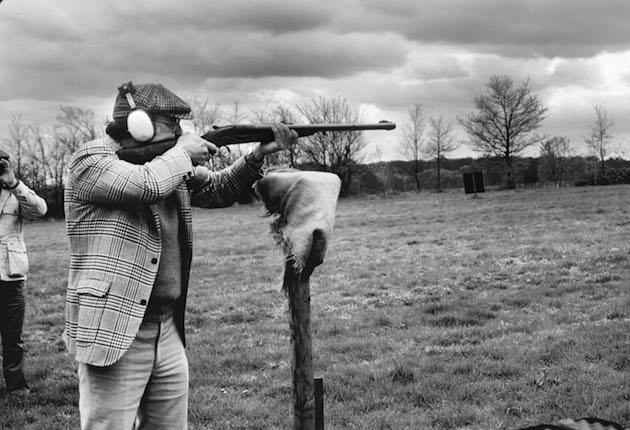Note: The following is an excerpt from Classic Carmichel: Stories From The Field, a collection of articles written during Jim Carmichel’s 30 years as the rifle editor of Outdoor Life. Order your copy today!
The 50-yard shooting station had a padded T-rest that could be used for a steadier aim but I elected to go it offhand. A padded shooting jacket or some extra padding at the shoulder would have been a smart idea when shooting the .700, but I wore only a light coat. After all, I came to see what it was really like to shoot the world’s most powerful sporting rifle, so my only protections were ear muffs and shooting glasses.
The time had come and I squared myself at the target. Cameras clicked in all directions. My wife, Linda, looked solemn and our American friends were clearly concerned. Other onlookers wore expressions that said, “I’m glad it’s you, chum, and not me.”
A box was opened and two gleaming cartridges produced—too big to be real—more like phallic artifacts than ammunition. I had anticipated firing the rifle only once but here were two rounds. Was I twice blessed? At a cost of more than $100 each for the .700 cartridges, my friends at H&H were being more than generous. Or was it worth it to see an American get kicked on his pants?
For a moment I rested the sights on the target, then opened the breech. One of the Holland staff dropped a round into the right barrel, then stepped well back. Clicking the safety to off, I raised the rifle and settled the plump bead in the wide notch of the express sight. For a few seconds my aim was steady and I gradually increased trigger pressure.
But it wouldn’t fire. After what felt like ten pounds of pull I gave up, dropped the muzzles to the T-rest, and took another breath. The trigger pull was too heavy and more than the usual finger pressure would be needed to release the sear. So again I raised the rifle, braced myself, and hauled back on the trigger.
The effect was not like being kicked on the shoulder, but instead like running into a brick wall in the dark. The recoil of heavy-caliber rifles has been described by some writers as a “push.” With a .700 Nitro, such a silly description doesn’t apply unless having a 130-pound sandbag dropped on you can be called a push. There was also a momentary impression that my nose and jaw were no longer in alignment.
Eventually my eyes refocused on the target and the .70-caliber hole was easy to see, but not in the black square where I had aimed.
“Put another one in,” I ordered, opening the breech so the attendant could load the left barrel. This time my finger was on the rear trigger, a somewhat better position, and I determined to squeeze it as carefully as possible.
The next recoil seemed more violent than the first.
The muzzles reared to a nearly vertical angle, causing the butt to slip off my shoulder. For an instant I fought to hold onto the rifle but then regained my grip. The second hole missed the center of the square by only an inch. There was applause and more applause, and a kiss from my wife.
I had fired the mighty .700 Nitro.



Am sure if ole’ Elmer were arond he would say..”yep, that’s enough gun”!
I shot an 8 bore Westley Richards double rifle which had a stock a tad short for me. My thumb met my nose, my nose introduced itself to my ear lobe then tears formed in my eyes and snot ran out my nose. I asked my friend if my nose was straight and he reply “About as straight as usual.” Three of us shot right barrel standing at 50 yrds and all three holes touched. It later went to Africa with new owner where he took several trophies with it.
I will pass on the 700 NE. 577’s are plenty enough for me.